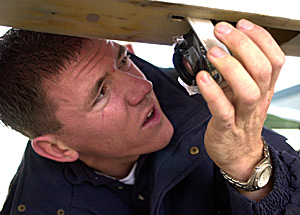 |
|
WILL SEBERGER/Arizona Daily Wildcat
|
Keith Brock, an aerospace engineering senior and the Aerial Robotics Club president, adjusts a belly-mounted video camera on one of the club's unmanned aircraft on Saturday at the model aircraft park on the far west side of Tucson. The club builds airborne robots to compete in national competitions.
|
|
|
By Jessica Lee
Arizona Daily Wildcat
Monday, March 1, 2004
Print this
Despite the chilly weather early Saturday morning, the UA Aerial Robotics Club was out in the desert flying its small-scale airplanes.
Club members were testing groundbreaking research, trying to construct planes that will fly ÷ not with direction from onboard pilots, but with the help of computers, cameras and global positioning system technology.
The Tucson International Modelplex Park Association, east of the Tucson Mountains, is the hangout for the club that met to demonstrate its latest innovation: a 2-ounce Styrofoam glider that can be launched from a 4-foot-long plane in midair and land on a specific target.
The glider has a camera attached to its belly that enables students to watch images of the ground on a computer. Global Positioning System coordinates allow the computer to know where the glider is and where it must land.
With the annual International Aerial Robotics Competition on the horizon, the club has little time to spare to invent an aircraft that can accomplish several daunting "missions."
The team spends about 20 hours per week designing, programming, testing, building and, of course, crashing planes, gliders and helicopters ÷ all in the hope of eventually winning the prize at the international competition.
The competition, sponsored by the Association for Unmanned Vehicle Systems, challenges universities from across the globe to complete four missions at the urban battlefield training area at Fort Benning, Ga. The team to finish the four levels will win the pot of money. That $40,000 prize will inspire the UA club to work hard for the rest of the semester.
Unlike other competitions, the aerial robotics contest is so difficult that it must carry over year after year until a team wins. And each year, the prize increases by $10,000.
"We don't think anyone will win it again this year," said Jess Dooley, an aerospace engineering senior.
Last year, the UA finished level one, trailing behind Georgia Institute of Technology, the only school to complete level two.
Many who consider flying remote-controlled airplanes a piece of cake might think the four missions are nothing but a technological nightmare.
Mission one, which the UA already completed, involves programming a small aircraft to fly on its own around three GPS coordinates and then land back on the runway.
The team is now focused on mission two. It must not only get the plane to fly by itself over a fake urban city, but must also design computer programs that enable the plane to identify a target atop one of the buildings.
Ekaterina Taralova, a computer science sophomore, is one of the two students who work on networking and computer imaging.
"We don't really know how people recognize images in their brain, so it is hard to make a computer Īsee' an image," she said.
The plane then has to take pictures of the building, identify any open doors and windows, and convince the judges the aircraft can get into the building.
That's where the glider comes in.
The UA team plans to launch a glider, which can pass through a window, off a plane. Mission three begins inside.
Once in the building, the nose of the glider will pop off and a small rover will drive out. Using cameras, the team will have to identify one of three things: a panel on a nuclear reactor, a hostage situation or a tapestry on the wall. That information will be sent to the judges.
Mission four involves repeating all of the first three missions in an uninterrupted sequence.
"This is some of the top research in the world," said Jon Leonard, the senior manager for advanced programs at Raytheon in Tucson. "This is a very advanced club."
Automated flight technology that the team researches can be applied to fighting fires, performing search and rescue, tracking migrants and assisting the military.
On a small budget of approximately $34,000, the UA is forced to borrow equipment, solicit companies and stay in cheap hotels in Georgia.
Keith Brock, an aerospace engineering senior and club president, said the sponsors of the club are Raytheon, Advanced Ceramics Research, Net Media Incorporated, Boeing and Lockheed Martin.
Georgia Tech, the team in first place thus far, has a $4 million budget.
Last year, the team came home with three awards, including best technical paper, most innovative design and best technical presentation.
After driving 36 hours straight in one 15-passenger van, the team found the three-day competition so intense that it hardly slept.
Evenings were spent preparing presentations and fixing the planes.
"We were hermits in our Motel 6 room," Dooley said.
"I thought it would be a vacation, but it wasn't. We didn't get much sleep," Taralova said.
